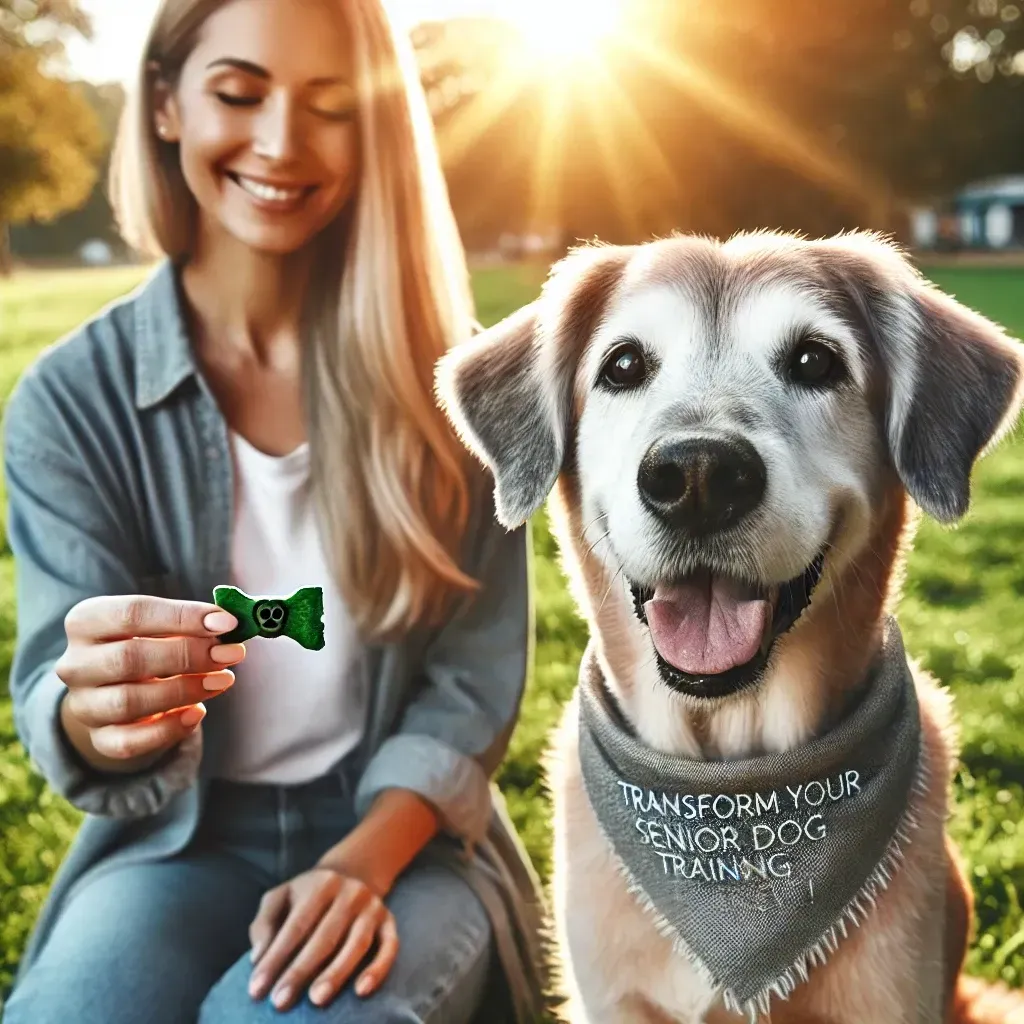
Transform Your Senior Dog Training Experience with These 5 Essential Techniques!
Training your senior dog is both possible and beneficial. Older dogs can learn new things, just like puppies. It may take a bit more time and patience, but the rewards are great. Your furry friend can improve their behavior, strengthen your bond, and have a happier life.
Key Takeaways
- Senior dogs can learn new skills and commands.
- Training helps improve behavior and strengthens the owner-dog bond.
- Using positive techniques is crucial for effective training.
- Patience and consistency are important when training older dogs.
- Seek help from a professional trainer if needed.
- Explore additional resources for senior dog care and training techniques.
Understanding Senior Dogs and Their Needs
As dogs get older, they may face different challenges. Health issues like arthritis or difficulty hearing can affect how they learn. It is important to understand these needs. Know that training for a senior dog should be gentle. Always be aware of their physical limits.
Why Train a Senior Dog?
Training a senior dog can help in many ways. It can:
- Improve Behavior: Older dogs may develop habits that need to change. Training can correct these behaviors.
- Enhance Safety: Teaching commands like "come" or "stay" can keep your dog safe.
- Strengthen Bonds: Training together builds trust and a strong bond between you and your dog.
Common Challenges with Senior Dogs
Senior dogs may not be as eager to learn new things. They may also have health issues that make learning harder. Here are some common challenges:
- Reduced Energy: Older dogs may tire quickly. Keep training sessions short and fun.
- Less Focus: They may not concentrate as well. Use treats or toys to keep their attention.
- Memory Issues: Some senior dogs may forget commands. Be patient and repeat commands often.
| Challenge | Description | Training Tips |
|---|---|---|
| Reduced Energy | Older dogs may tire more quickly than younger ones. | Keep sessions brief and engaging. |
| Less Focus | Senior dogs may have a harder time concentrating. | Use treats to grab their attention. |
| Memory Issues | Older dogs might forget commands they've learned. | Repeat commands consistently. |
Tips for Training Your Senior Dog
Training a senior dog requires special techniques. Here are some helpful tips to get started.
1. Take it Slow
When training, start with simple commands. Use short sessions to avoid tiring your dog. Keep the lessons fun and playful. This helps them stay interested.
2. Use Positive Reinforcement
Reward your dog with treats or praise when they follow a command. This encourages them to repeat the behavior. Avoid using punishment. It can harm your bond and make training harder.
3. Be Consistent
Use the same words and signals for commands. This helps your dog understand what you want. Consistency is key in training. Make sure everyone in your household uses the same commands.
4. Keep Sessions Short
Aim for 5 to 10 minutes per session. Short bursts of training can help your dog learn without feeling overwhelmed. End each session on a positive note.
5. Focus on Their Health
Before starting training, check with your vet. Make sure your dog is healthy enough to train. If they have any pain or discomfort, adjust your training plan.
6. Make Training Fun
Incorporate games and fun activities. Use toys and playtime as rewards. This keeps your dog engaged and makes learning enjoyable.
- Considerations for Training Senior Dogs:
- Always monitor your dog’s energy levels during sessions.
- Use soft mats for comfort if they have joint issues.
- Incorporate rest breaks to prevent fatigue.
Commands to Teach Your Senior Dog
Here are some basic commands to teach your senior dog.
Sit
This is a simple command but very useful. It helps establish calm behavior. To teach this command:
- Hold a treat above your dog's nose.
- Move the treat back while saying, "Sit."
- When your dog sits, give them the treat.
Stay
This command is essential for safety. To teach "stay":
- Ask your dog to sit.
- Open your palm and say, "Stay."
- Take a step back. If they stay, reward them.
Come
This command helps keep your dog safe. To teach "come":
- Use a leash in a safe area.
- Call your dog’s name and say, “Come.”
- Reward them when they reach you.
Down
Teaching your dog to lie down can be calming. To teach this command:
- Hold a treat in front of your dog’s nose.
- Move the treat down to the ground.
- Once they lie down, reward them.
Leave It
This command can be helpful in many situations. To teach "leave it":
- Hold a treat in your hand and show it to your dog.
- Close your hand and say, "Leave it."
- Once they stop trying to get the treat, reward them with another treat.
When to Seek Professional Help
If you find training challenging, it might be time to get help. A professional trainer can provide guidance tailored to your dog's needs. They can help with specific issues like aggression or anxiety.
Finding the Right Trainer
Look for trainers who understand senior dogs. They should use positive training methods. Read reviews and ask for recommendations. A good trainer will work with you and your dog to create a plan.
Consider exploring expert advice on advanced training techniques for older dogs to further enhance your training sessions.
Creating a Safe and Comfortable Training Environment
Your home should be a safe place for training. Remove any distractions that can make it hard for your dog to focus.
Setting Up a Training Space
- Choose a Quiet Area: Pick a room where your dog can focus without distractions.
- Use Soft Surfaces: If your dog has trouble standing for long, use soft mats.
- Have Water Nearby: Always keep water available for your dog during breaks.
| Training Environment Setup | Importance | Suggestions |
|---|---|---|
| Quiet Area | Reduces distractions | Use a room away from noise |
| Soft Surfaces | Comfort for older joints | Use blankets or mats |
| Water Availability | Keeps your dog hydrated | Have a bowl nearby during training |
Keeping Your Senior Dog Mentally Active
Training is just one way to keep your older dog engaged. Here are a few activities that can keep their minds sharp.
Interactive Toys
Puzzle toys can challenge your dog and keep them busy. These toys often have hidden treats to motivate your dog.
Short Walks
Gentle walks are great for exercise. They provide mental stimulation and allow your dog to explore new smells.
Socialization
Allow your dog to meet other pets. This helps them stay social and can reduce anxiety.
Common Misconceptions About Senior Dog Training
There are many myths about training older dogs. Let’s look at a few.
Older Dogs Can’t Learn New Tricks
This is not true. Older dogs can learn just like puppies. They may need more time, but they can succeed.
Training is Only for Young Dogs
Training is beneficial at any age. Senior dogs can improve their behavior, learn new commands, and enjoy life more.
Training Should be Punitive
Using punishment can harm your relationship. Positive reinforcement is the best way to train your dog. It builds trust and encourages good behavior.
Building a Strong Relationship with Your Senior Dog
Training is not just about commands. It’s also about building a bond. Here are ways to strengthen your connection.
Spend Quality Time Together
Make time each day for just you and your dog. Play, cuddle, and enjoy each other’s company.
Understand Their Body Language
Learn to read your dog’s signals. Understanding when they are happy, stressed, or tired can help you connect better.
Be Patient
Training takes time, especially with older dogs. Be patient and celebrate small victories.
Conclusion: Training Your Senior Dog is Worth It
Training your senior dog can be a rewarding experience. With patience and love, you can help them learn and grow. Remember to keep it fun and positive. The bond you create during training will be priceless. Your furry friend deserves the best, and training is a big part of that.
So, grab some treats, find a quiet spot, and start your training journey today!
